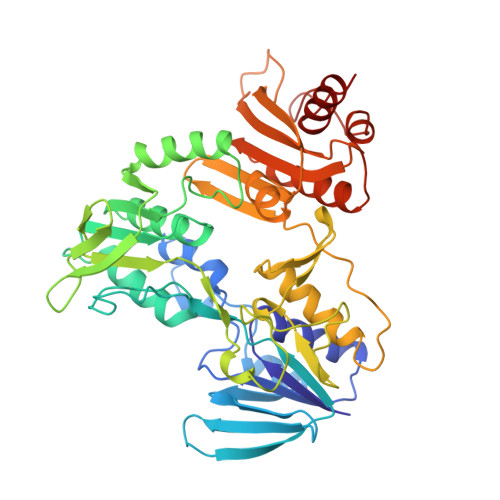Crystallographic analyses of NADH peroxidase Cys42Ala and Cys42Ser mutants: active site structures, mechanistic implications, and an unusual environment of Arg 303.
Mande, S.S., Parsonage, D., Claiborne, A., Hol, W.G.(1995) Biochemistry 34: 6985-6992
- PubMed: 7766608
- DOI: https://doi.org/10.1021/bi00021a010
- Primary Citation of Related Structures:
1NHP, 1NHQ - PubMed Abstract:
NADH peroxidase from Enterococcus faecalis is a tetrameric flavoenzyme of 201,400 Da which employs Cys 42 as a redox-active center cycling between sulfhydryl (Cys-SH) and sulfenic acid (Cys-SOH) states along the catalytic pathway. The role of the active site cysteine 42 in NADH peroxidase has been elucidated using biochemical and crystallographic techniques. Here we describe the crystal structures of two active site cysteine mutants, Cys42Ala and Cys42Ser, which were determined to 2.0 A resolution and refined to crystallographic R values of 17.6 and 18.3%, respectively. The overall chain fold and the quaternary structure of the two mutants appear to be very similar to wild-type enzyme. Therefore, the substantially lower activity of the mutants is due to the absence of the Cys-SOH redox center. One of the oxygen atoms of the nonnative cysteine sulfonic acid in the wild-type structure is replaced by a water molecule in both mutant structures. Two other residues near the active site are His 10 and Arg 303. A detailed analysis of the environment of these residues in the mutant and wild-type peroxidase structures indicates that the imidazole ring of His 10 is uncharged. The interactions made by the guanidinium group of Arg 303 involve not only His 10 but also the carboxylate of Glu 14 and Tyr 60. Interestingly, the Nn1H function of Arg 303 is oriented perpendicular to the plane of the phenyl ring of Tyr 60 with a Nn1 to phenyl ring center distance of 3.8 A, suggesting a favorable electrostatic interaction between Arg 303 and Tyr 60.(ABSTRACT TRUNCATED AT 250 WORDS)
- Department of Biological Structure, School of Medicine, University of Washington, Seattle 98195, USA.
Organizational Affiliation:


















